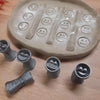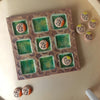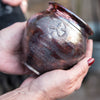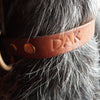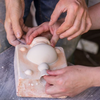Kuro raku in the Czech Republic
Inspiration
Great part of western potters consider the technique of removing a red-hot ceramic piece from a gas furnace, followed by a reduction, as today's already classic burning method. So called „American raku“ has gained a wide range of admirers since its origin in the middle of the last century. Soon, this new approach has also reached the Old Continent. It was at the time when Europe was divided by an impenetrable barrier. As a result, the flow of information has stopped and czech potters did not get many information about the raku. As soon as was possible, they found great excitement in new techniques. Perhaps the greatest attraction was towards the American raku.

It quickly came into general awareness and firmly took its place amongst the other techniques.

Looking closer at the raku technology one cannot notice the difference between so-called American

and original Japanese raku which is reduced to only 2 basic colors – red

and black.

Several friendly Czech potters saw the raku technique as a vast tree in fields that can be seen from everywhere but its roots are hidden beneath its branches. At the time in a report on pottery portal www.artkeramika.cz, Vladimir Groh described his participation in the burning of black and red raku during his stay in the pottery center in the Shigaraki – a place about forty kilometers from Kyoto, the cradle of original raku.

These few paragraphs were like a detonator to everyone. A group with working name Rentai emerged and its members enthusiastically started to discover the king of chawans – Raku yaki. These spontaneus beginnings were the foundation for the gradual formulation of the main goal – rebuilding the original Japanese techniques of creating and burning tea bowls, as they have been formed in the Raku for centuries, but with the exclusive usage of local Czech ingredients.

The main theme of study for now is black raku or kura raku. Vladimir’s article has shown that the main ingredient of glazes for centuries has been Kamogawa ishi – black stone from the Duck River flowing through Kyoto. Soon its chemical analysis was discovered on the internet. At this point the group is joined by Viktor Goliáš, a geologist working at the Faculty of Science of the Charles University, who significantly contributes with his knowledge of minerals and rocks. He confirms the conjectures that Kamogawa ishi belongs to the group of basaltoids, but primary seeks chemical analyzes of Czech basaltic and points to sites with rock most similar to the Japanese one. And so the whole lot is on the way to adventurous wanderings for long-time extinct volcanoes to collect glaze raw materials.

An important milestone was the discovery and later the acquisition of the original 1736 Japanese handbook titled „The Secret of Black and Red Raku“. Even though the book has not yet been translated, it has become an essential source of information on the design of original charcoal furnaces thanks to its illustrations.

First experiences with kuro raku
The first burnouts in two replicas of archaic devices were conducted at the Černohorak 2015 seminar in pottery center Doupě.

Two furnaces were tested. In addition to the construction taken from ancient Japanese manual, a similar but brick variant was built. In order to melt the glaze from pure basalt it was necessary to attain a temperature of at least 1200°C, under conditions that no one had any experiences with. However shortly after the furnace were controlled and many design parameters were understood. Charcoal surprised the experimenters with its incredible performance. At a temperature of 1495°C in the combustion chamber, due to very aggressive environment, the first platinum sensor burned.

Here, for economic reasons, no more measurements were conducted. The temperature in the muffle stabilized at an average of 1250°C and one firing cycle lasted about 10 minutes. The basaltic tests carried out before the seminar confirmed the assumption that they had strong tendency to crystallize and therefore came out too dry and brown than semi-dim black.

Thanks to the rapid heat treatment, the polish and colour of the glaze came very close to the famous Japanese designs of the Raku family.

The results of the seminar encouraged everyone and it was clear that the group would soon meet again.

Kuro raku 2016 – goals of the seminar
The enthusiastic organizers immediately began preparations for Kuro raku 2016. This year’s event was supposed to be in rather unusual form. The goal was to organize a public experiment with an accompanying exhibit mapping kuro raku technology. It was a rather difficult task. To perfect preparations of experiment, preparation of backgrounds and the organization of the public and the participants were just five months left.
If last year’s goal was to gain basic information of basalt’s ability to form glaze and to achieve required temperature using charcoal, this year’s experiment was formed together by several advanced sub-targets aimed at producing tea bowls meeting the demanding chadó criteria.
- Deeper understanding of basalt glazes. Use of basalt from other local areas. The use of various fluxes, especially traditional lead in the form of frit and pure oxides. The assembly of a glaze sampler and creation of systematic glazing database.
- Stabilization of otherwise very dynamic burning process.
- Replacing the modern fan with a reconstructed blacksmith bellows from 1854
- Creating chawan using technique called „tezuke“ using specially made steel knives.
- Searching, analyzing, extracting and processing ceramic material identical to the material currently used in Kyoto for production of raku. Making sampler of the materials.
- Verification of the possibilities of modern lightweight refractories and modified structure of the current hatch furnace.
- Construction and utilization of a new hard fireclay segment furnace to minimize casing cracks and parallel testing of new muffle materials.

Results of the seminar
Furnaces
A total of four furnaces were in operation at the seminar. It was the last year’s fireclay plate furnace, a segmented furnace and a foam-fireclay furnace adapted from conventional hatch electric furnace. The last was a gas furnace, which served to preheat all ceramics.
With impatient expectations, a new segmented furnace was launched with the historic bellows. Small segments cut from hard fireclay block containing 42% AL2O3 showed excellent resistance to cracks caused by extreme temperature gradient. Despite the fact that heating from zero to combustion temperature 1500°C took only 60 minutes. The thermal capacity of dense fireclay was not defective and positively reflected on the stability of the combustion process. At the end of the day, after ten hours of uninterrupted burning, it was clear that the melt of ash and fireclay slowly filled the air vents, and the blowing became more and more laborious. This problem will be solved by building a hearth in which the melt can flow freely.
Last year’s segmented furnace once again confirmed its qualities. Besides the simplicity of the construction and the low production costs, thanks to its small weight it is especially easy to handle. Although the temperature in the combustion chamber reached the same values as a year ago, the cracks in the casing did not expand. The device is therefore still operable without any limitations. A better understanding of the combustion processes of charcoal led to almost routine burns in both furnaces. Rhythm and regularity had positively translated into final results in many ways. For us, it is still an exciting fact that Chójiro himself used similar furnaces in the middle of the seventeenth century.
Manual blowing is by its performance perfectly comparable to an electric fan. In additions, it can be more responsive to the ever changing resistance in the charcoal layer. The considerable drawback of a vertical double-acting bellows is its large size and weight. In the future, we are planning to manufacture a traditional Japanese fuigo bellows. Besides bellows and furnaces, we were also interested in the design of the original pliers for the handling of red-hot ceramics. After a number of remodeling, some of these were forged and the seminar was enriched with yet another interesting detail.

Testing gas and charcoal combustion in a modified foam-fireclay hatch furnace opened new topics for burning kuro raku, especially in conjunction of propane-butane. Lightweight fireclay bricks commonly used in electric furnaces are very quickly subjected to the negative thermo-chemical effects of charcoal ash. Even though the inner face was laid out with cordierite sheets, the ten-centimeter liner was eroded to a stainless steel casing within a few hours of burning. Experiences with foam-fireclay and many experiments with various propane-butane burners became the foundation for a new design of a gas double chamber furnace with once chamber for preheating heated by waste heat from chamber with operating temperature.
The synchronization of the glazing laboratory, glazing room and three burning stations with one preheating furnace facilitated the system of accompanying for each product or sample and the perfect coordination of all fourteen experimenters.
Finding the right matter was greatly facilitated by a piece of material used for raku imported directly from Kyoto. This way we have obtained a good reference sample. The Czech Republic is geographically quite rich. With the help of geologists and technologists of individual mining sites, it was easy to provide a number of suitable raw clays for testing. For each composition, we were interested in colour, structure, plasticity, resistance to temperature shocks, shrinkage by drying and by burning and porosity. All of this on six gradually rising temperatures. In order to obtain an authentic expression, it was necessary to omit industrial technologies and to process clay only by hand kneading. This way, it was possible to find matters with technological and artistic properties identical to the original.
The most common technique of making still remains circular molding on a potter’s wheel, but premiere use of the traditional process of cutting a bowl from thick-walled semi-finished product has opened up completely new possibilities of working with a piece of shard and enriched the repertoire of techniques as an important and authentic means of expression. This original procedure allows for a much more responsive reaction to the condition of the semi-finished product at any given moment. To fulfill the idea of chanoya (Japanese tea ceremony), it is a great advantage to keep the bowl in the palms during the whole process of its creation. So is increased the metaphysical transfer between the creator and the bowl.

Popularization of kuro raku
As an important part of our work, we also see the presentation of Japanese raku to the professional and lay public. Visitors to the event had the opportunity to watch all the experiments. Those interested could try their work with the furnace. Rewarding them besides unforgettable experience was a bowl, which was hand-made with health-neutral glaze and fired in charcoal. The event was accompanied by a vernissage of the successful exhibition “Black Raku Technology”, mapping the entire production process from sources of inspiration through the extraction of clay and basalt, modeling of the bowls, production of samples to the preparation of glazes and, of course, firing. The exposition was continuously expanding with just finished test tiles and tea bowls. The exhibition was complemented by exhibits familiar with the domestic production of individual experimenters. Visitors also welcomed the tours of the bonsai center of Jiří Svačina, on whose grounds the seminar took place.

Conclusion
A detailed introduction to the results of the seminar far exceeds the scope of this article. In short, they can be characterized as very successful and encouraging. But by far it does not mean answering all the questions about kuro raku. Some topics have been solved only partially and some completely new have emerged during the experiments. Many important questions remain deliberately unresolved so far. The Rentai group, despite some funding constrains, is still ready to experience further adventures to better understand the phenomenon called kuro raku.
Back to Inspiration
-
Posted in
Kuro Raku

